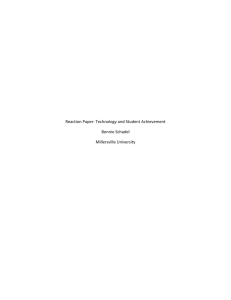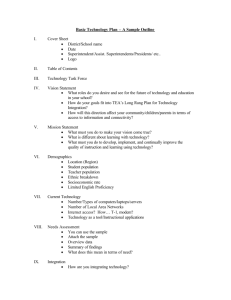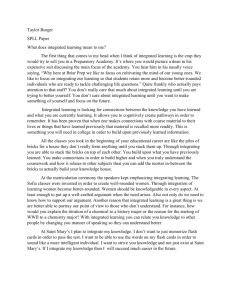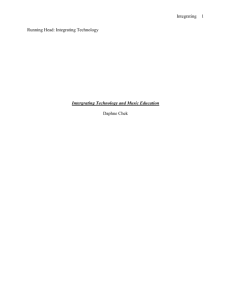Solutions to Midterm #1 Practice Problems
advertisement
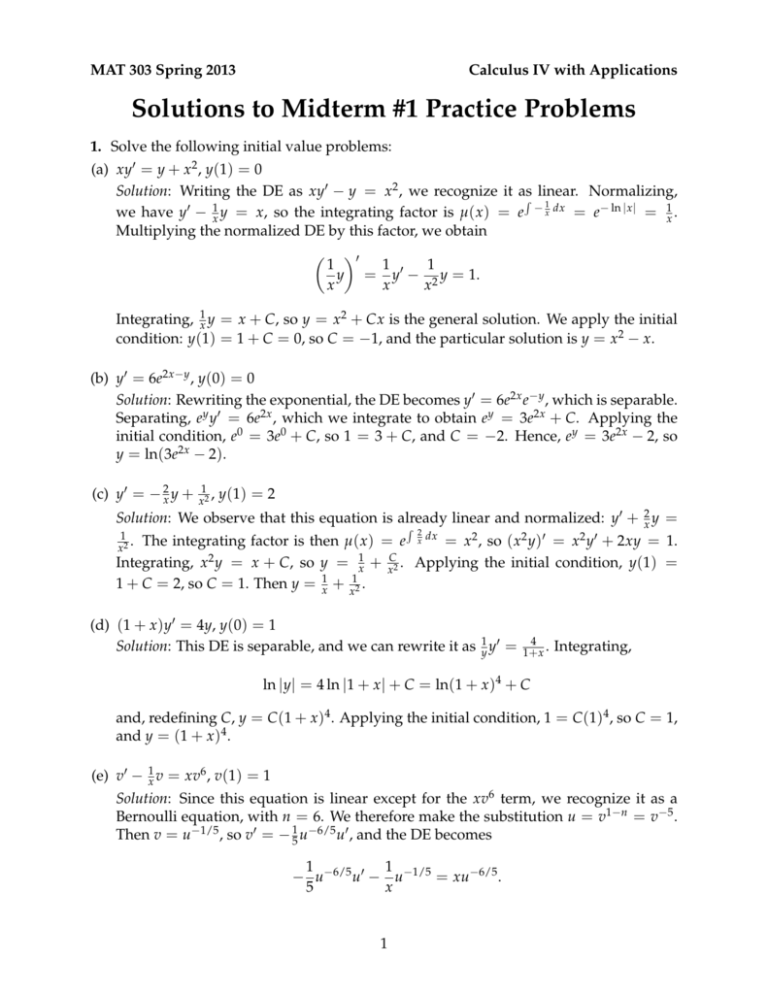
MAT 303 Spring 2013 Calculus IV with Applications Solutions to Midterm #1 Practice Problems 1. Solve the following initial value problems: (a) xy0 = y + x2 , y(1) = 0 Solution: Writing the DE as xy0 − y = x2 , we recognize it as linear. Normalizing, R 1 1 − 0 we have y − x y = x, so the integrating factor is µ( x ) = e x dx = e− ln | x| = 1x . Multiplying the normalized DE by this factor, we obtain 1 y x 0 = 1 0 1 y − 2 y = 1. x x Integrating, 1x y = x + C, so y = x2 + Cx is the general solution. We apply the initial condition: y(1) = 1 + C = 0, so C = −1, and the particular solution is y = x2 − x. (b) y0 = 6e2x−y , y(0) = 0 Solution: Rewriting the exponential, the DE becomes y0 = 6e2x e−y , which is separable. Separating, ey y0 = 6e2x , which we integrate to obtain ey = 3e2x + C. Applying the initial condition, e0 = 3e0 + C, so 1 = 3 + C, and C = −2. Hence, ey = 3e2x − 2, so y = ln(3e2x − 2). (c) y0 = − 2x y + 1 , x2 y (1) = 2 Solution: We observe that this equation is already linear and normalized: y0 + 2x y = R 2 The integrating factor is then µ( x ) = e x dx = x2 , so ( x2 y)0 = x2 y0 + 2xy = 1. Integrating, x2 y = x + C, so y = 1x + xC2 . Applying the initial condition, y(1) = 1 + C = 2, so C = 1. Then y = 1x + x12 . 1 . x2 (d) (1 + x )y0 = 4y, y(0) = 1 Solution: This DE is separable, and we can rewrite it as y1 y0 = 4 1+ x . Integrating, ln |y| = 4 ln |1 + x | + C = ln(1 + x )4 + C and, redefining C, y = C (1 + x )4 . Applying the initial condition, 1 = C (1)4 , so C = 1, and y = (1 + x )4 . (e) v0 − 1x v = xv6 , v(1) = 1 Solution: Since this equation is linear except for the xv6 term, we recognize it as a Bernoulli equation, with n = 6. We therefore make the substitution u = v1−n = v−5 . Then v = u−1/5 , so v0 = − 51 u−6/5 u0 , and the DE becomes 1 1 − u−6/5 u0 − u−1/5 = xu−6/5 . 5 x 1 MAT 303 Spring 2013 Calculus IV with Applications Multiplying by −5u6/5 , this equation normalizes to u0 + 5x u = −5x, with is linear in u( x ). The integrating factor is x5 , so we have ( x5 u)0 = −5x6 , which integrates to x5 u = − 57 x7 + C. Dividing by x5 , v −5 = u = 5x2 C − . 7 x5 We apply the initial condition, so 1 = C − 57 , and C = 12−5x7 , 7x5 12 7. Then v−5 = 12 7x5 − 5x2 7 = so s v= 5 7x5 . 12 − 5x7 (f) 2xyy0 = x2 + 2y2 , y(1) = 2 x Solution: We try normalizing this DE, dividing by 2xy to obtain y0 = 2y + yx . We observe that y0 is expressed entirely in terms of y/x, so we let v = y/x. Then y = xv and y0 = xv0 + v, so this DE becomes xv0 + v = 1 + v. 2v 1 Hence, xv0 = 2v , which is separated, so 2vv0 = 1x . Integrating, v2 = ln | x | + C, so p p v = ± ln | x | + C, and y = ± x ln | x | + C. √ Applying the initial condition, 2 = ±1 C, so we must take the positive branch of the square root, and C = 22 = 4. Then the solution to the IVP is √ y = x ln x + 4, and is valid for x > 0. 2. Find the (complete) general solution to each of the following differential equations: (a) y0 + 2xy + 6x = 0 Solution: We observe that this DE is linear, with integrating factor µ( x ) = e 2 e x . Then the DE becomes R 2 0 2 2 2 x x2 e y = −6xe − → e x y = −3e x + C ⇒ y = Ce−x − 3. R 2x dx = (b) (3x2 + 2y2 ) dx + (4xy + 6y2 ) dy = 0 Solution: Given the format of the DE, we check whether the coefficient functions M ( x, y) = 3x2 + 2y2 and N ( x, y) = 4xy + 6y2 make it exact. Since My = 4y and 2 MAT 303 Spring 2013 Calculus IV with Applications Nx = 4y, it is. We can then integrate M with respect to x to find a function F ( x, y) such that this DE is dF = 0, up to pure y-indeterminacy in F: F ( x, y) = Z 3x2 + 2y2 dx = x3 + 2xy2 + g(y). Then Fy = 4xy + g0 (y), but this is also N = 4xy + 6y2 , so g0 (y) = 6y2 . Then g(y) = 2y3 + C, so one value for F is x3 + 2xy2 + 2y3 . Finally, solutions to the DE are the level sets x3 + 2xy2 + 2y3 = C, which cannot easily be solved explicitly for y. (c) xy00 + y0 = 12x2 Solution: Since y is not present in this DE, we recognize it as being a reducible secondorder equation. We take p( x ) = y0 , so y00 = p0 . Thus, we obtain the linear DE xp0 + p = 12x2 . Since the left-hand side is already ( xp)0 , we integrate to get xp = 4x3 + C, so y0 = p = 4x2 + Cx . Integrating again, y = 43 x3 + C ln x + D. (d) 9y0 = xy2 + 5xy − 14x Solution: Factoring an x out of the terms on the right-hand side, 9y0 = x (y2 + 5y − 14), which reveals that the DE is separable. Hence, we separate this to y2 9 y0 = x, + 5y − 14 which excludes the constant solutions y = 2 and y = −7. We use partial fractions to decompose the fraction on the left-hand side. Since y2 + 5y − 14 = (y + 7)(y − 2), we have B 9 A + = 2 ⇒ A(y + 7) + B(y − 2) = 9. y−2 y+7 y + 5y − 14 Plugging in y = −7 and y = 2, we see that A = 1 and B = −1. Then integrating, Z 1 1 − dy = y−2 y+7 Z x dx ⇒ ln |y − 2| − ln |y + 7| = Combining the difference of the logs and exponentiating, y= y −2 y +7 = Ce x 1 2 x +C 2 2 /2 . Solving for y, 9 − 7. 2 1 − Ce x /2 Setting C = 0 recovers the solution y = 2, but no value of C gives y = −7, so we record this as a singular solution not incorporated into the general solution. 3 MAT 303 Spring 2013 Calculus IV with Applications 2 (e) y0 + 3x y + 3y−2 = 0 Solution: We recognize this as a Bernoulli equation with n = −2, so we make the substitution v = y1−n = y3 . Then y = v1/3 , so y0 = 31 v−2/3 v0 . Thus, the DE becomes 2 1 −2/3 0 v v + v1/3 + 3v−2/3 = 0 3 3x ⇒ 2 v0 + v = −9. x This DE is linear in v with integrating factor µ( x ) = x2 , so ( x2 v)0 = −9x2 . Integrating, x2 v = −3x3 + C, so v = −3x + C/x2 . Since y = v1/3 , r 3 C y= − 3x. x2 (f) y0 + y cot x = cos x x Solution: We see that this equation is already linear, with p( x ) = cot x = cos sin x , so R its integrating factor is µ( x ) = e cot x dx = eln | sin x| = sin x. Multiplying by this integrating factor, we get (y sin x )0 = sin x cos x, so integrating gives y sin x = 1 2 sin2 x + C, and y = 1 2 sin x + C sin x . (g) x2 y0 + 1x y3 = 2y2 y3 y2 Solution: We start by normalizing the DE: y0 + x3 = 2 x2 . Then the entire DE can be written in terms of y0 and y/x, so it is homogeneous. Making the standard substitution v = y/x, y0 = xv0 + v, we have xv0 + v + v3 = 2v2 , 1 so xv0 = −v3 + 2v2 − v = −v(v − 1)2 . Separating variables, we have − v(v− v0 = 1x . 1)2 By partial fraction theory, we expect to be able to decompose this fraction as − 1 A B C = + + . 2 v v − 1 ( v − 1)2 v ( v − 1) Then −1 = A(v − 1)2 + Bv(v − 1) + Cv, so we set v = 0 and v = 1 to determine A = −1 and C = −1. Then −1 = −(v − 1)2 − v + Bv(v − 1), so expanding and cancelling terms we have that B = 1. Thus, we integrate: Z 1 1 1 − − dv = v − 1 v ( v − 1)2 Z 1 dx x ⇒ ln |v − 1| − ln |v| + 1 = ln | x | + C. v−1 Exponentiating and using v = y/x, we obtain the implicit solution x x 1− e y−x = Cx. y 4 MAT 303 Spring 2013 Calculus IV with Applications (h) ( xy + y2 ) dx + x2 dy = 0 Solution: We check whether this DE is exact: letting M( x, y) = xy + y2 and N ( x, y) = x2 , we compute My = x + 2y and Nx = 2x. Since these are not equal, the DE is not exact! y2 y dy We instead divide by x2 dx to obtain x + x2 + dx = 0, which is homogeneous. Then letting v = y/x, we have v + v2 + xv0 + v = 0, so xv0 = −2v − v2 = −v(v + 2). 1 Separating variables, − v(v+12)v0 = 1x , and by partial fractions, v(v1+2) = 21 ( 1v − v+ 2 ). 1 1 0 2 Therefore, ( v+ 2 − v ) v = x , so integrating gives ln |v + 2| − ln |v| = C + 2 ln | x |. 2 2 2 2 2 Exponentiating, v+ v = Cx , so v = Cx − 1, and v = Cx2 −1 . We also potentially omitted the solutions v = 0 and v = −2 when we divided above, but the case C = 0 recovers v = −2. Finally, we recover y, as y = xv = 2x , Cx2 − 1 or y = 0. (i) y0 = ( 4x + 1)y Solution: This equation is separable, so we separate variables to get 1y y0 = Cx4 e x . ln x4 Integrating, ln |y| = + x + C, so y = solution y = 0, but we recover it when C = 0. (j) (2x − ln y ) dx x2 + 1 xy 4 x + 1. Dividing by y above excludes the dy = 0 Solution: We check for exactness: M( x, y) = 2x − ln y x2 and N ( x, y) = 1 xy , so My = − x12 y and Nx = − x12 y . Hence, the DE is exact. We integrate M with respect to x: F ( x, y) = Then Fy = 1 xy + g0 (y) = N = for F ( x, y) is x2 + ln y x , Z 1 xy , 2x − ln y ln y dy = x2 + + g ( y ). 2 x x so g0 (y) = 0, and g(y) is constant. Hence, one choice and the solutions are level sets x2 + ln y = C. x 3 Solving for y, ln y = Cx − x3 , so y = eCx− x . 5 MAT 303 Spring 2013 Calculus IV with Applications dy 4y = 2 . dx x −4 (a) Find all values a and b such that this equation with the initial condition y( a) = b is guaranteed to have a unique solution. 3. Consider the differential equation 4y Solution: We let f ( x, y) = x2 −4 , so that this DE is y0 = f ( x, y). Then both f and its derivative f y ( x, y) = x24−4 are continuous for x 6= 2 and x 6= −2. Hence, for all a not equal to 2 or −2 and all b, the DE with the initial condition y( a) = b has a unique solution. (b) Find the general solution to the differential equation. Solution: We note that this equation is separable, so we separate it into 4 1 1 1 0 y = 2 = − , y x−2 x+2 x −4 which excludes y = 0 as a solution. Integrating, ln |y| = ln | x − 2| − ln | x + 2| + C. Exponentiating, 4 x−2 = C 1− , y=C x+2 x+2 with the case C = 0 corresponding to the solution y = 0 that we would otherwise have missed. These are hyperbolas along the axes x = −2 and y = C. (c) Sketch a slope field for this equation, along with several representative solutions. Are there any points where solutions exist but are not unique? Solution: Below is a slope field with several solutions: 4 2 0 -2 -4 -4 -2 0 6 2 4 MAT 303 Spring 2013 Calculus IV with Applications We see that all of the parabolas to the right of x = −2 intersect at the point (2, 0), so this is a point where uniqueness fails but existence does not. 4. A cold drink at 36°F is placed in a sweltering conference room at 90°F. After 15 minutes, its temperature is 54°F. (a) Find the temperature T (t) of the drink after t minutes, assuming it obeys Newton’s law of cooling. Solution: The DE governing the temperature T (t) is T 0 = −k( T − A), where A = 90. Writing this as a normalized linear DE, then, it becomes T 0 + kT = 90k, so the integrating factor is ekt . Hence, (ekt T )0 = 90kekt , so integrating yields ekt T = 90ekt + C, or T = 90 + Ce−kt . Finally, applying the initial condition T (0) = 36 gives that C = 36 − 90 = −54. Hence, the temperature is given by T (t) = 90 − 54e−kt . 2 −36 We now determine k: T (15) = 90 − 54e−15k = 54, so e−15k = − 54 = 3 , and k = Therefore, t 2 15 − 15t ln 32 = 90 − 54 T (t) = 90 − 54e . 3 1 15 ln 32 . (b) How long does it take for the drink to reach 74°F? Solution: We set T = 74 and solve for t: 90 − 54 ( 32 )3 . Then t/15 = 3, so t = 45 min. 2 3 15t = 74, so 2 3 15t = −16 −54 = 8 27 = 5. A tank with capacity 500 liters originally contains 200 l of water with 100 kg of salt in solution. Water containing 1 kg salt per liter is entering at a rate of 3 l/min, and the mixture is allowed to flow out of the tank at a rate of 2 l/min. (a) Find the amount of salt in the tank at any time t before it starts to overflow. Solution: We set up a differential equation for the amount x (t) of salt in the tank at time t. The volume of solution in the tank is V (t) = 200 + (3 − 2)t = 200 + t, so dx dt is given by dx x (t) 2 = rin cin − rout cout = (3)(1) − 2 = 3− x. dt 200 + t 200 + t R 2 Then x 0 + 2002+t x = 3, which is linear, with integrating factor µ(t) = e 200+t dt = e2 ln |200+t| = (200 + t)2 . Then ((200 + t)2 x )0 = 3(200 + t)2 , so integrating gives (200 + t)2 x = (200 + t)3 + C ⇒ 7 x (t) = 200 + t + C . (200 + t)2 MAT 303 Spring 2013 Calculus IV with Applications At time t = 0, x (t) = 100, so 100 = 200 + Thus, C , 2002 x (t) = 200 + t − and C = −100(200)2 = −4 × 106 . 4,000,000 . (200 + t)2 (b) Find the concentration (in kg/l) of salt in the tank at the time when the tank overflows. Solution: The concentration in the tank is given by c(t) = x (t) 4,000,000 . = 1− V (t) (200 + t)3 The tank overflows when V (t) = 500, so at this time c = 1− 4,000,000 4 = 1 − = 1 − 0.032 = 0.968 kg/l. 125 5003 (c) If the tank has infinite volume, what is the limiting concentration in the tank? Solution: We have that 4,000,000 lim c(t) = lim 1 − = 1 kg/l. t→∞ t→∞ (200 + t)3 6. Suppose that at time t = 0, half of a “logistic” population of 100,000 persons have heard a certain rumor, and that the number of those who have heard it is then increasing at the rate of 1000 persons per day. How long will it take for this rumor to spread to 80% of the population? Solution: Let P(t) be the number of persons in the population who have heard the rumor. Then P(0) = P0 = 50,000, and P0 = kP( M − P), with M = 100,000. Furthermore, P0 (0) = 1000, so 1000 = k (50,000)(100,000 − 50,000) = k (50,000)2 = (2.5 × 109 )k, and k = 1 2.5×106 = 4 × 10−7 . Thus, kM = (4 × 10−7 )(100,000) = 4 × 10−2 = 1/25. Recalling that P(t) is given by P(t) = MP0 , P0 + ( M − P0 )e−kMt we solve P(t) = 80,000 for t. Then 80,000 = (100,000)(50,000) 50,000 + (50,000)e−t/25 ⇒ 4 1 = 5 1 + e−t/25 Then −t/25 = ln 14 = −2 ln 2, so t = 50 ln 2 ≈ 34.7 days. 8 ⇒ e−t/25 = 5 1 −1 = . 4 4 MAT 303 Spring 2013 Calculus IV with Applications 7. Consider the differential equation y0 + tan y = 0. (a) Find all equilibrium solutions to this equation, and characterize their stability, with justification. Solution: Since the DE is y0 = f (y), with f (y) = − tan y, we look for solutions to − tan y = 0. This occurs when sin y = 0, or when y = nπ for any integer n. Hence, we expect equilibria at these y values. Furthermore, for nπ − π2 < y < nπ, − tan y is positive, and for nπ < y < nπ + π2 , − tan y is negative, so each equilibrium y = nπ is stable. Alternately, since f (y) = − tan y is differentiable at each nπ, we examine f 0 (y) = − sec2 y = − cos12 y there: cos nπ = ±1, so f (nπ ) = − 11 = −1. Thus, the derivative is negative, so f (y) is decreasing across this equilibrium, and it is therefore stable. (b) Find the general solution to the differential equation, and sketch a few representative solutions. Solution: We note that this DE is separable, since it is autonomous, and we separate it cos y into − tan1 y y0 = − sin y y0 = 1. Integrating, and using u-substitution with u = sin y, − ln | sin y| = x + C. Then sin y = Ce− x , redefining C, and y = sin−1 (Ce− x ). We note that there is some ambiguity in sin−1 : canonically, it takes values between −π/2 and π/2, but it may be translated by 2nπ, or translated by (2n + 1)π with a sign reversal. In any case, we obtain the following representative graphs for y for different choices of C and the arcsine branch: 10 5 0 -5 -10 0.0 1.0 0.5 9 1.5 2.0 MAT 303 Spring 2013 Calculus IV with Applications 8. Consider the differential equation y0 = y2 − 4y − 4k2 + 8k with parameter k. (a) Given k = 2, find the critical points of the differential equation, draw a phase diagram, and determine the stability of the critical points. Solution: When k = 2, the DE is y0 = y2 − 4y − 16 + 16 = y2 − 4y = y(y − 4). Thus, the equilibria are y = 0 and y = 4. Since y2 − 4y is a parabola opening upwards, its values are negative between 0 and 4 and positive otherwise. Hence, we have the following stability diagram: + − 0 0 y0 sign y + 0 4 Thus, the equilibrium y = 0 is stable, and the equilibrium y = 4 is unstable. (b) Draw the bifurcation diagram for this differential equation, and label the stability of the equilibria. Solution: We solve y2 − 4y − 4k2 + 8k = 0 to find the equilibria for general k: using the quadratic formula, √ √ 4 ± 16 + 16k2 − 32k 4 ± 4 k2 − 2k + 1 y= = = 2 ± 2( k + 1). 2 2 Thus, the equilibria are y = 2 + 2k − 2 = 2k and 2 − 2k + 2 = 4 − 2k, which are straight lines in the yk-plane. By the stability analysis above, the upper branch is unstable, and the lower branch is stable. Finally, when the branches meet at k = 1 and y = 2, that equilibrium is semistable. We illustrate this below (red is unstable, green is stable): 8 6 4 2 -2 -1 1 -2 -4 10 2 3 4 MAT 303 Spring 2013 Calculus IV with Applications 9. A boat moving at 27 m/s suddenly loses power and starts to coast. The water resistance slows the boat down with force proportional to the 4/3-power of its velocity. Suppose the boat takes 20 seconds to slow down to 8 m/s. What is the total distance the boat travels as it slows down to a stop? Solution: The DE governing the velocity of the boat is v0 = −kv4/3 , which is separable. 1 Then v−4/3 v0 = −k, so integrating gives −3v−1/3 = C − kt. Hence, v−1/3 = v1/3 = 1 1 3 C + 3 kt. Applying the initial condition v(0) = v0 = 27 = 3 , 3 = C + 0, so C = 13 . Therefore, v1/3 = 11 = 1 11 = 1+3kt , and C + 3 kt 3 + 3 kt v(t) = 27 . (1 + kt)3 We now determine k. At t = 20, v(t) = 8, so 8 = so 1 + 20k = 32 , and k = 1 2 1 · 20 = 27 . (1+20k)3 Then (1 + 20k)3 = 27 8 = ( 23 )3 , 1 40 . We determine x (t), the distance that the boat travels over time. Integrating v(t) = 27(1 + kt)−3 from 0 to t, t 27 1 1 1 −2 (1 + kt) = 1− x ( t ) − x0 = 27(1 + kt) = 27 . −2 k 2k (1 + kt)2 0 0 1 27 Then limt→∞ x (t) = limt→∞ = 2k 1 − (1+kt)2 = 27 2k . With k = 1/40, this is 27(20) = 540 m. Z t −3 11
